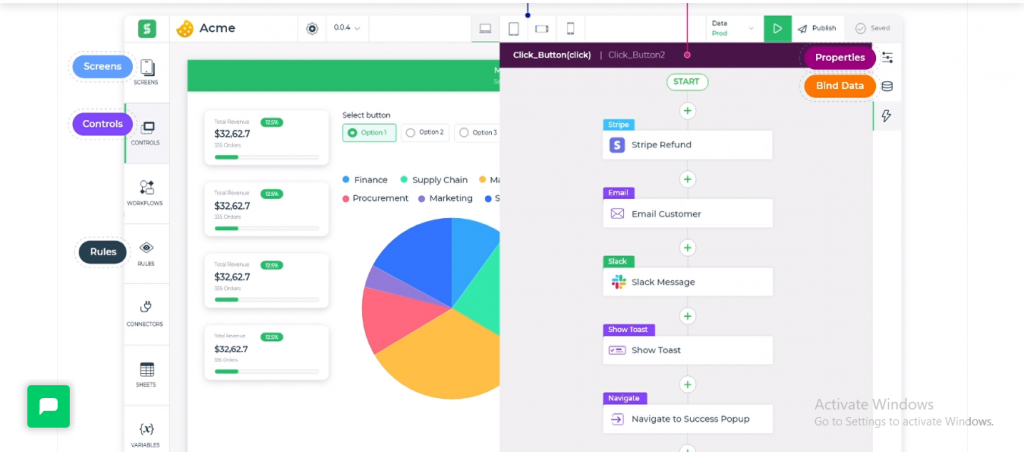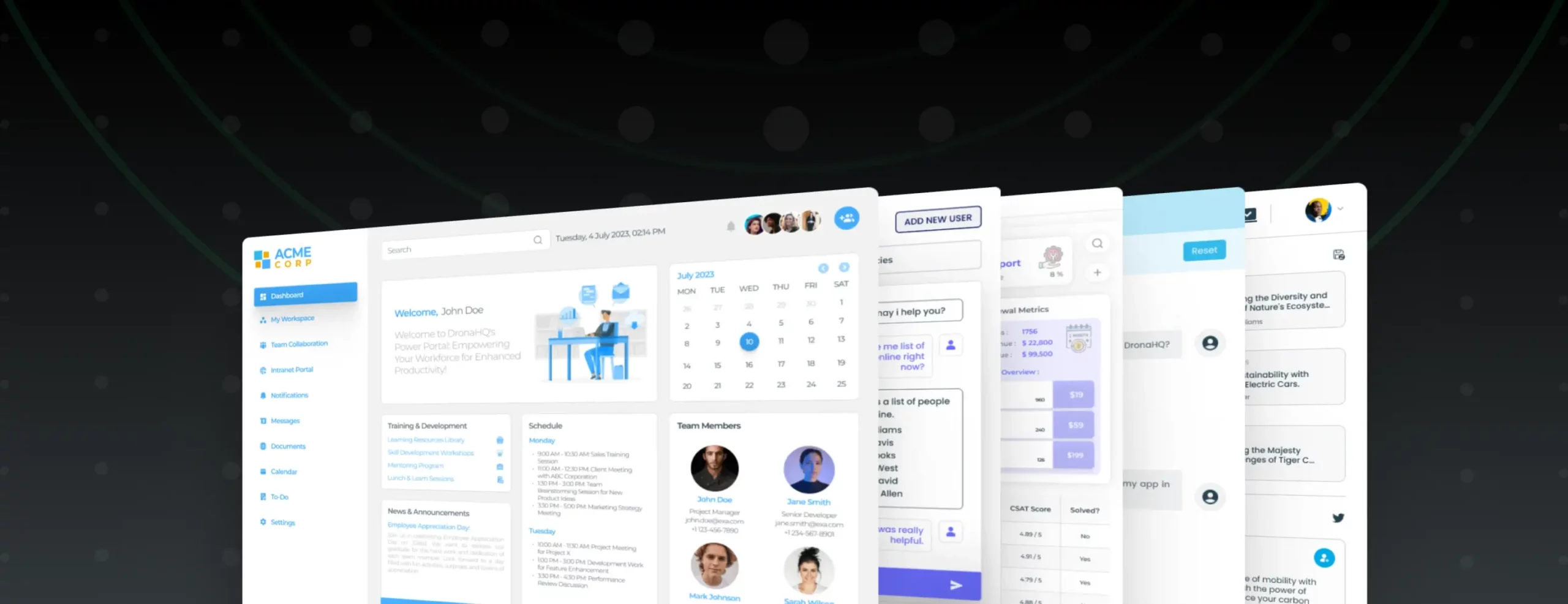
No Code Platforms
No Code Platforms: Modern Approach to Application Building
Gone are the days when it would take multiple approval cycles, PoCs, beta testing for business owners to find a solution for their operational requirements. No-code platforms are the modern approach to building comprehensive applications at speed and with minimal operational cost. Moreover, business users will be able to fully control how their applications look and function without relying on IT professionals. We will discuss everything about a no-code platform, including features, components, and current trends. Stay tuned to learn more!
What is a No-Code development platform?
No code platforms offer drag-and-drop tools and a user-friendly interface to empower internal users and citizen developers to build software applications. Developers of all technical capabilities can use the pre-built components of the platform to build a highly functional app at an accelerated speed.
Users can use WYSIWYG editors and several built-in UI components from a library of ready-to-use resources to assemble and design applications, integrate with various third-party services, like Stripe, Salesforce, SAP, My SQL, MongoDB, Airtable etc., and build an application quickly. Many of the applications developed using no-code applications are utilized by enterprise-sized businesses to automate internal business processes and workflows such as approval processes, centralizing data entry, data administration tools, and dashboards. These tools empower teams to innovate solutions to address their specific departmental issues.
Why Use No-Code Development Platforms?
Only 0.5% of the world’s population knows how to code; needless to say, there is a lot of demand to create solutions (customer-facing as well as internal facing) for engineers already. Thanks to no-code, the development pace can be accelerated by bypassing traditional IT development restrictions of time, money, and scarce human capital resources allowing teams to align their business strategy with a rapid development process. Here are some more reasons why using no-code platforms can benefit your business.
Accelerated delivery of applications
No-code platforms accelerate the process of application development and delivery. Unlike traditional development, which involves a lot of complex coding that prolongs the development period, no-code solutions offer a visual approach to application development.
Relieving engineering backlog
IT professionals are already preoccupied with a lot of IT functions. As a result they have limited time to invest in learning the internal business concerns and innovate internal tools that target department-specific issues. Since no-code platforms empower internal users to innovate applications, IT professionals can focus on the core IT activities of an organization without any extra burden of coming up with internal solutions.
Enabling the existing talent pool and cross-team collaboration
Low code enables the backend developers to visually design frontend applications. Engineers can integrate and bind disparate systems without purchasing expensive automation tools or hiring external help. Low code further helps in bridging the gap between the business users and the IT team that supports them by promoting transparency and cross-team collaboration. Both the subject matter experts and the engineering team can get involved in the application development process.
Developing custom software is expensive. In addition to recruiting highly skilled programmers, you may have to hire front-end and back-end developers, financial experts, security consultants, and cloud experts to design your project. This can result in a high development cost.
You don’t have these concerns with a no-code solution because all the underlying systems, like cases, databases, or security, are already taken care of. All you need is to pick elements from the drag-and-drop builder and arrange them to build a highly functional and secured application with no extra cost.
How does a No-code platform work?
No-code platforms involve a lot of coding that happens in the backdrop. All the heavy lifting keeps happening behind the scenes, which is invisible to the users. These platforms utilize data encapsulation and abstraction to conceal the complexity of creating applications. No code platforms use a visual IDE, a software tool to consolidate basic tools essential for software writing and testing.
No-code platforms allow users to visually select and connect reusable components representing particular steps or capabilities (containing the actual code) and link them together to create the desired functionality. These platforms also offer experimenting, prototyping, testing, and deployment features. This type of development is called point-and-click development for its flexibility and effortless development capabilities.
Features of a No-Code Platform
20% of people use the word ‘ease of use’ while describing low-code/no-code platforms. Let’s have a look at the top features of a no-code platform that makes it so user-friendly and popular.
Drag-and-drop interface
The drag-and-drop interface is one of the primary features of a no-code platform. It is also one of the reasons for the popularity and expansion of no-code platforms throughout the years. With this central functionality, you can easily drag and drop components to create a visually appealing application that can be personalized to your desirability. The no-code platform allows users to rapidly construct mobile app pages and screens by dragging blocks that include text, charts, containers, buttons, forms, and more. Users can instantly see how these pages look on desktops, mobile, and tablets.
API and DB Integration Connectors
Most no-code development platforms have integration connectors to databases and server-side applications or provide an intuitive user interface to connect to your preferred database in a codeless manner. These integrations simplify data connection to your sources to the front end. Users can also simply bring their CSVs into built-in DB-Sheets and easily integrate with all web services like Slack, My SQL, Zendesk, Airtable, and more.
Visual modeling tool
No-code development platforms enable users to assemble pre-configured components to build applications effortlessly. Users only need to arrange drag-and-drop modules into a logical chain to customize their applications. Since everything has already been visually modeled, it prevents users from performing complex coding activities.
Reusability
No-code platform utilizes a boilerplate code, users can use multiple small parts of a particular application to build a new one. This reduces work to a whole new extent and benefits business users by reusing parts and functionalities of their applications. With reusable components, users can create a modern layer around outdated legacy systems or enhance core systems by building functionalities that are missing in those systems.
Responsive across devices
Efficient no-code platforms like DronaHQ are web+mobile responsive. This means you can design your app’s visual looks on web devices such as laptops and computers and mobile devices and tablets (iOS + android). They will work efficiently across devices.
Scale with Governance
No-code development platforms support IT and citizen developers‘ collaboration. These two work together by maintaining visibility and control over the organization’s application ecosystem. IT teams can set policies and monitor the consumption of business resources such as APIs and data by business teams.
Security Features
In Spite of offering a quick and flexible environment for app building, no-code platforms’ offer strong security features like-
1. Single sign on and authentication
2. Role based access control
3. Platform security audits and compliance.
4. Application access control and audits
5. Secure code using plugins
6. Secure API endpoints
How can you build an application with a No-Code Platform?
Business users, citizen developers, and experts can build a fully functional, powerful application with a no-code platform in 3 simple steps.
Design the visual layout
You have the authority to design the look and feel of your app. Utilize components by dragging and dropping from the library of templates and effectively structure the theme to match your brand image. You can also apply custom color schemes, upload company logos, select font type, and even upload your own custom icons.
Assemble components
No-code platforms offer preconfigured components. All you need is the structure and arrange them in the sequence you want. All the content can be easily edited, deleted, and updated. You just need to point and click to configure a fully functional app.
Publish
After you have designed the layout and configured elements in the logical flow, your app is ready to be launched. Just click on publish, and your app is ready to be explored by internal and external users.
No-Code Development Platforms Trends
84% of enterprises have turned to low-code/no-code to reduce strain on IT resources, and reduce time to market. Have a look at the current trends for no-code platforms that are here to stay for a while.
Increasing use of no-code/low-code code platforms by small and large-scale organizations
82% of large and small-scale organizations cannot attract and retain skilled software engineers. As a result, many organizations have turned to low-code/no-code solutions to save time and resources. Compared to the traditional development approach, no code enables businesses to create powerful applications with much lesser cost, time, and effort without any dependence on IT. This is one of the primary reasons for their increasing popularity. With this trend. Gartner predicts that 70% of all applications developed by enterprises will be with the use of low-code/no-code platforms by 2025.
Low-code/No-code platforms will boost the growth of microservices.
No code platforms are popular among companies because it accelerates the rate of development of microservice applications. According to Gartner, 42% of microservices utilize low code/no code, which is expected to increase to a massive 58% by 2024. Users can utilize several APIs to reconfigure their monolithic applications into modern microservices with low-risk and high-impact functions. And all of this can be achieved without the in-house IT department, cutting down the delivery time of applications.
Crossover between IoT Systems and low code/no code
The Internet of things has a complex nature and are meant to process a comparatively large amount of data from the initial to endpoint devices like sensors, car, mobile communication devices, and so on. Low code/no code platforms enable users to build high-performance applications converting large amounts of data into content-aware visuals. For this reason, 40% of automation in the IoT trust low code/no code platforms for a robust and rapid application-building experience.
AI Products will grow with Low code/no code
Businesses are expected to readily adopt low-code intelligent systems to enhance AI and image visual analysis. The market is expected to reach $187 billion by 2030 with the increasing use of artificial intelligence. Businesses keep adopting AI technologies to expedite business processes and reach goals faster.
Low Code/no code will enhance business process automation in companies
No code platforms enable companies to access, use, and share logic, processes, and server-side data. Low-code/no-code allows businesses to apply automation and enhance the workflow of business process management applications. It enables the automation of business processes in a short period while integrating seamlessly with existing APIs. 26% of executives named low-code/no-code as their most important automation investment, which has more than doubled since covid (from 10% to 26%)
How We Chose the Best No-code Development Platforms?
Here are the top things you must look for when deciding to sign up for no-code/Low-code platforms–
Functionality
The first thing you need to consider while choosing a no-code development platform is the scope of your project and how the functionalities offered by the platform will complement it. If it offers enough data connections, APIs, and integrations, how vast and effective are the templates and components, and if the application will be responsive across devices, web, and mobile (iOS and Android).
Automation capabilities
Automation of crucial workflows simplifies business processes to a great extent and low-code platforms are the perfect facilitators of that. So while deciding on a low-code platform, ensure to weigh its automation capabilities. Sophisticated process automation can reach into databases, email, and transactional systems flawlessly. This can be applied to small tasks like updating spreadsheets to bigger functions like automating email notifications.
Usability
With the right no-code platform, users are allowed to create powerful applications, websites, and other projects rapidly. These platforms are built to make modern development more accessible and approachable. Therefore usability is another key criterion when looking for the best no-code platform. Usability means how effectively and effortlessly you can use the platform, how intuitive the interface is, or how high or low is the learning curve. Any problems or lag with the platform can significantly impact your workflow and bring down productivity.
Analytics
Another key criterion you must consider while choosing a low-code platform is its analytical capabilities. Top platforms will generate detailed and accurate visualizations from your data that you get internally through reports and dashboards, or externally via customer-facing portals. Some no-code platforms also offer predictive analytics that take the analyst through an automated series of steps to enable data-driven decision-making.
Customer Support
Whenever you sign up for the services of a platform, customer support is an important factor that helps you onboard seamlessly into the platform. Customer support should be readily available to help fix issues and solve problems, as there might be times when you encounter inconvenience in terms of bugs and other technical lags. Select a provider who will be readily available and assist you throughout the development journey.
Why DronaHQ is the best no-code platform?
DronaHQ offers rich UI controls and pixel-perfect designs for an effortless, exciting, and intuitive app development journey. It features web+mobile output (android +iOS), user-based unlimited end-user support for the starter and business pricing plans, frontend action flow builder, and more. Customize anywhere with JavaScript, create custom UI components without writing code, and add your branding. Choose from over 50+ out-of-the-box API and DB integration connectors and seamlessly unify disparate data into one platform.
DronaHQ offers a point-and-click interface to automate tasks in minutes, no code frontend logic, server-side logic to query the database, run approval workflow, and more. With SOC-II certifications and enterprise-grade security, DronaHQ ensures users work in a safe and secure environment. Sign up now for a 14-day free trial!




